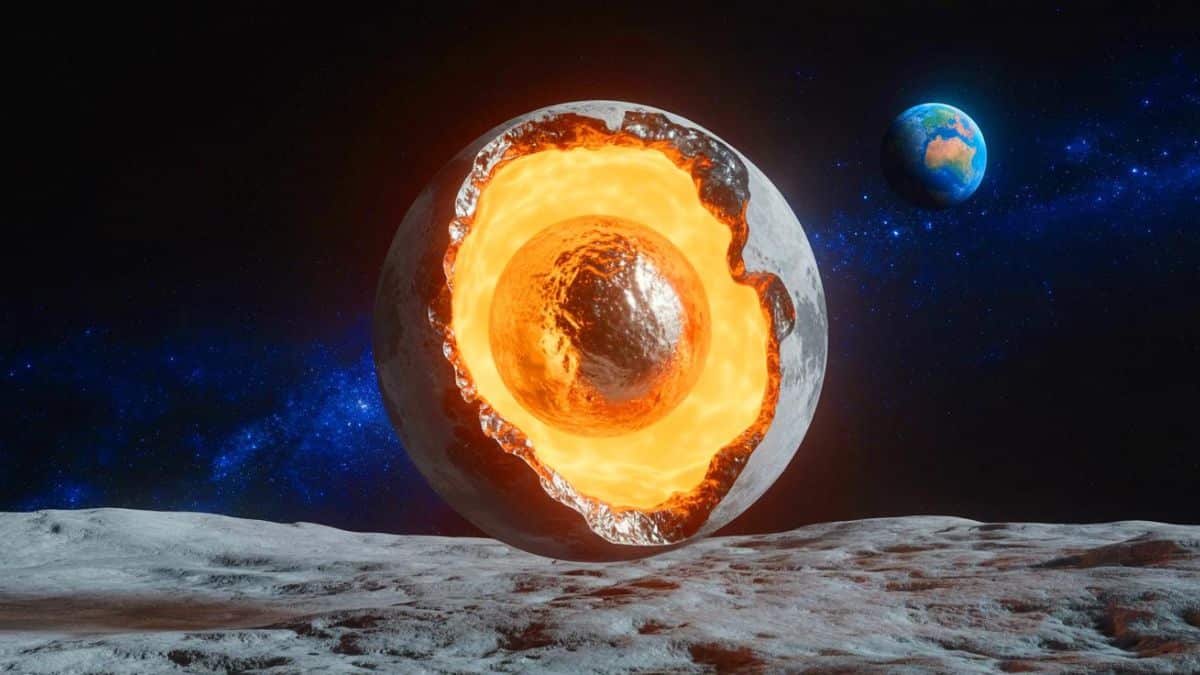The recent lunar core discovery marks a pivotal moment in our understanding of Earth’s only natural satellite. Scientists have confirmed that the Moon harbors a solid inner core with a density similar to iron, solving a long-standing debate about the nature of the lunar heart. This revelation not only reshapes our knowledge of the Moon but also provides critical insights into the formation of our solar system.
Inside the Moon: a surprising similarity to Earth
For decades, scientists have wondered about the true composition of the Moon’s interior. The breakthrough came in May 2023 when researchers definitively identified a solid inner core at the Moon’s center. This finding represents a major advancement in lunar science that connects directly to the Moon’s origin story.
Arthur Briaud and his research team combined data from various space missions and lunar laser ranging experiments to create a comprehensive profile of lunar characteristics. Their analysis examined:
- The Moon’s gravitational deformation caused by Earth
- Variations in Earth-Moon distance over time
- Lunar density measurements across different layers
- Seismic wave patterns from Apollo mission data
These investigations revealed that the lunar core structure mirrors Earth’s in fundamental ways. The Moon possesses an outer fluid layer surrounding a solid inner core, with the outer core measuring approximately 362 kilometers in radius and the inner core about 258 kilometers—roughly 15% of the Moon’s total radius.
The density of this inner core, approximately 7,822 kilograms per cubic meter, closely resembles iron, challenging earlier theories about lunar composition. While Apollo-era seismic data proved valuable, its limited resolution left the exact nature of the deepest lunar interior uncertain until this study.
The record for the largest treasure of all time has just been confirmed at $17.4 billion, but two countries are fighting over the rights to the discovery
In 2019, Iceland Approved the 4-Day Workweek: Nearly 6 Years Later, All Forecasts by Generation Z Have Come True
The magnetic mystery of lunar evolution
Perhaps the most fascinating implication of this discovery relates to the Moon’s magnetic history. Evidence suggests that shortly after formation, the Moon possessed a powerful magnetic field that began declining approximately 3.2 billion years ago. Understanding the core’s composition provides crucial context for explaining this magnetic evolution.
The newly confirmed core structure helps explain the mechanism behind the Moon’s magnetic field generation and subsequent decline. This magnetic field, like Earth’s, would have been generated by convection movements within the core. The relationship between core composition and magnetic field history creates a timeline of lunar thermal evolution that extends back to the earliest days of our solar system.
The research also identified active overturn within the lunar mantle—dense material sinking toward the center while less dense material rises. This dynamic activity could explain the presence of certain elements in volcanic regions on the lunar surface, further supporting the team’s model of lunar interior structure.
| Lunar Structure | Radius (km) | Density (kg/m³) |
|---|---|---|
| Total Moon | 1,737 | 3,344 (average) |
| Outer Core | 362 | 5,200-7,000 |
| Inner Core | 258 | 7,822 |
“140 Trillion Times Earth's Oceans”: NASA Discovers Massive Water Reservoir 12 Billion Light‑Years Away
Hiker Hears Cry For Help On A Mountain And Solves A Months-Long Mystery
Future lunar exploration and broader implications
As humanity prepares to return to the Moon, these findings take on renewed importance. Future missions will likely deploy advanced seismic monitoring equipment capable of providing higher-resolution data to verify these discoveries. The confirmation of a solid inner core represents just the beginning of a new chapter in lunar science.
Beyond the Moon itself, this discovery has significant implications for understanding the broader solar system. The internal structure of celestial bodies provides critical clues about their formation and evolution. By confirming the Moon’s iron-rich solid core, scientists gain valuable insights into the processes that shaped not only the Earth-Moon system but potentially other planetary bodies throughout our cosmic neighborhood.
The most compelling aspect of this discovery may be how it connects to the origin of the Moon itself. Leading theories suggest the Moon formed from debris following a massive collision between Earth and a Mars-sized body called Theia. The similar core structures of Earth and Moon provide another piece of evidence supporting this shared history, further illuminating one of the most dramatic events in our planet’s distant past.
As we look toward establishing a permanent human presence on the Moon in the coming decades, this enhanced understanding of lunar composition will inform everything from resource utilization to construction methods. The secret at the Moon’s heart—hidden since the birth of our solar system—has finally been revealed, opening new pathways for exploration and discovery.







